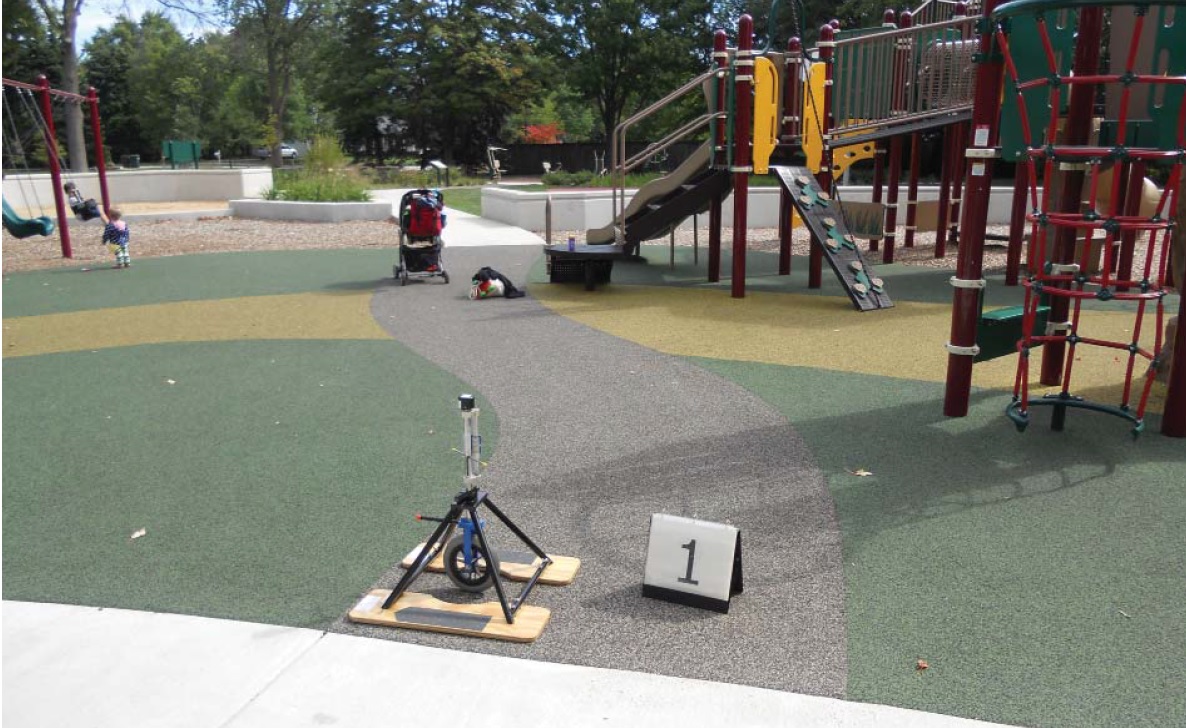Surfacing the Accessible Playground: 7 Things Every Playground Owner Should Know About the Accessibility of Their Playground Surfaces
2. Follow the Accessibility Standards for Play Areas
The 2010 Americans with Disabilities Act (ADA) Standards for Accessible Design apply to state and local governments (Title II) and places of public accommodation (Title III). The Architectural Barriers Act (ABA) Accessibility Standards apply to federal facilities. Both standards require newly constructed playgrounds and those existing playgrounds that are altered to comply with a series of technical provisions for accessible play components and the accessible route connecting these components.
The accessibility standards are minimum standards and do not require the entire play surface area to be accessible. The only required accessible surface area includes the accessible route from the entry of the play area, at least one connection to each accessible play component (points of entry and egress) and any clear space requirements adjacent to accessible play components. Children’s play behavior indicates they spontaneously move throughout the play equipment, navigating on their own preferred routes. Designing the entire use zone as a congruent accessible route is recommended as a best practice to accommodate the free play behavior of all children navigating the play space.
Playground owners, designers and maintenance personnel must have a good understanding of the requirements for accessible routes within the play area and comply with the provisions of the accessibility standards. Outside of the play area, an accessible route must connect at the site arrival point, include parking, and the path to the main entrance of the play area. The accessible route must also connect all accessible elements and features of the play area within the site.
Within the play area, the clear width of the ground level accessible routes shall be 60 inches minimum. Two exceptions may be applied: 1) In play areas less than 1000 square feet, the clear width of accessible routes shall be permitted to be 44 inches minimum, if at least one turning space is provided where the restricted accessible route exceeds 30 feet in length; or 2) the clear width of accessible routes shall be permitted to be 36 inches minimum for a distance of 60 inches maximum provided that multiple reduced width segments are separated by segments that are 60 inches wide minimum and 60 inches long minimum.

Where accessible routes serve ground level play components:
• The vertical clearance shall be 80 inches high minimum.
• The running slope not steeper than 1:16 or 6.25%.
• The cross slope shall not be steeper than 1:48 or 2.08%.
• Openings in floor or ground surfaces shall not allow passage of a sphere more than ½ inch diameter.
• Changes in level between ¼ inch high minimum and ½ inch high maximum shall be beveled with a slope not steeper than 1:2.
For a playground surface to be compliant, both safe and accessible, it must meet the above mentioned technical provisions for running slope, cross slope, openings, changes in level, and vertical clearance. Public playgrounds must also meet referenced standards set by the American Society for Testing Materials (ASTM) related to resilency [sic] for falls (ASTM F1292-99/04) and accessibility (ASTM F1951-99) around accessible equipment. Some jurisdictions and municipalities require surface systems to have certificates of compliance with ASTM standards. These certificates are often awarded through laboratory testing of surface samples. The standards require the actual site-installed surface systems to comply with ASTM F1292-99/04 and ASTM F1951-99.
The surface for the accessible route within the play area must meet the technical provisions of the standards as long as it is open for public use. Further, ground surfaces used for the accessible route are required to be inspected and maintained regularly and frequently to ensure continued compliance with ASTM F 1951-99. From the grand opening celebration to the coldest January day when parents bring their children outside to play and get some fresh air; as long as the playground is open for use, it must meet safety and accessibility standards.
Applying the Accessibility Standards to the Plan, Installation, and Maintenance of Ground Level Accessible Routes for Playgrounds
The following questions can be used through the planning process, during construction and as part of routine maintenance.
- Is the surface for the accessible route, clear ground space and turning space compliant with ASTM F1951-99 Standard Specification for Determination of Accessibility of Surface Systems Under and Around Playground Equipment?
- Does the playground surface comply with ASTM F1292-99/04 Standard Specification for Impact Attenuation of Surface Systems Under and Around Playground Equipment when ground surfaces are part of the accessible route and also located in the use zones?
- Is the accessible route part of the main circulation path and is it continuous to each accessible play component?
- Is the running slope for the ground level accessible route less than 1:16 or 6.25%?
- Is the maximum cross slope for the ground level accessible route less than 1:48 or 2.08%?
- Is there a minimum clear width of 60 inches for the ground level accessible route (some exceptions apply)?
- Are openings in the surface for the ground level accessible route no greater than .50 inch?
- Are changes in level along the ground level accessible route less than .50 inch beveled?
- Is the vertical clearance a minimum of 80 inches for the ground level accessible route?
- Does the clear ground space, 30 x 48 inches minimum, at egress of accessible equipment have a cross slope less than 1:48 or 2.08%?
- Are the ground surfaces inspected and maintained regularly and frequently to ensure continued compliance with ASTM F1951-99?
For more explanation on the application of the accessibility standards to public playgrounds, see A Summary of Accessibility Guidelines for Play Areas.

User Comments/Questions
Add Comment/Question